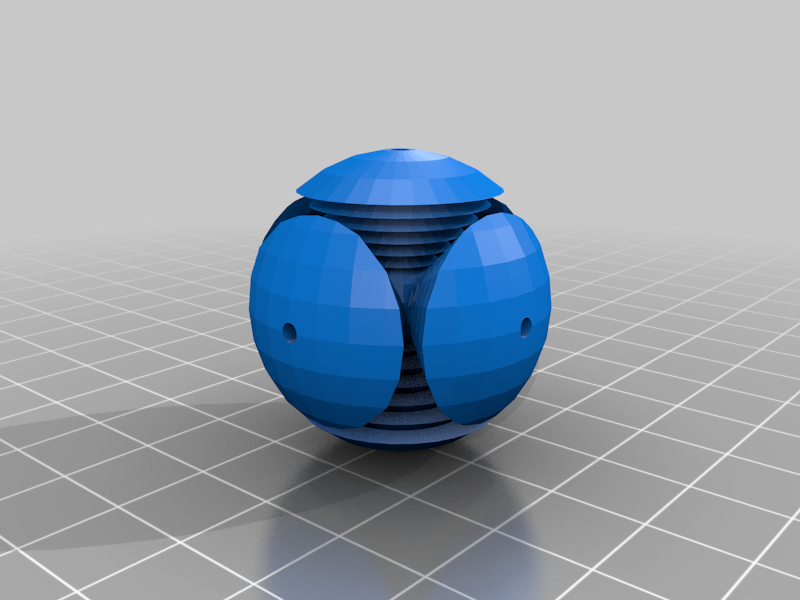
investigation of salt annealing of transparent pla parts chapter III
prusaprinters
<p>Hi everybody,</p> <p>This is chapter III of this investigation. Getting 100%infill or close to this parts made of transparent pla which is indeed transparent !!! Getting 3d printed lenses made of pla is not impossible anymore and can be achieved! With a better printer It would have been my next trial but I need to stop here.</p> <p>I further improved my remelting process in salt to get transparency using a sacrificial coating made of wood glue once completely dried. Coating which is watersoluble and avoid the frost pattern due to interaction witn salt particles.</p> <p>For letting the coating dry I fuse a spare filament 2-3 cm long to one edge of the dice. Which was perfect for an overall coating</p> <p>I did at 165°C for about 2 hours. The container is taken out of the oven then and need to cool rapidely (However I am not sure that it is very important . I think pla needs to stay amorph)<br/> For that I take the hot salt away with a spoon or alike.<br/> Maybe blowing little air with a metal tube willl do the job...nevertheless, I retrieve the pla transparent part rapidely, let set in cold water for 5 minutes brush them gently and then into pure ethanol.<br/> The surface is sticky. Let it dry.</p> <p>So to prove the transparency I printed a further dice:the hollow skull dice.<br/> An hollow part will colapse...so I used a trick.<br/> I filled the hollow part during printing with a 2 component Polyuretane coating mixed with littlevwater and a blue dye. As one can see on one of the picture.<br/> I let an air oulet on one side.<br/> I waited for 3 days and put it overnight at 60°C to cure completely the pu part inside<br/> Then I reworked it, and BAM! See for yourself. We see a distinguishable blue mass inside the dice! Yes! A nice transparent part with no frost!<br/> Still a long road to get a perfect shape retained after the sintering- but it is impossible with the printer I have. Which is ok for most things I do but too much air trapped still. Also when changing the Flow value to 120%...<br/> Nevertheless I hope someone will continue this if he has access on a decent 3d printer with settings that can avoid air trapping! Not alike the micro3d printer.</p> <p>I believe this would work with PET or MABS but you need a coating which sustains the hotter heat treatment for PET...not trivial...and secondly the cooling. If cooling is too slow it may form a non transparent body (amorphous vs crystalline phase of the polymer).</p> <p>Let me know if you start something alike!</p> <p>Best Regards</p> <p>Froggy.</p> <p>NOTA: Part I below</p> <p>After having see the video from Stefan CNC Kitchen<br/> Here below<br/> <a href="https://www.cnckitchen.com/blog/testing-the-strength-of-3d-prints-re-melted-in-salt">https://www.cnckitchen.com/blog/testing-the-strength-of-3d-prints-re-melted-in-salt</a><br/> Also he did a re sintering in plaster in an early attempt, another did a previous work with salt and a clear filament<br/> <a href="https://hackaday.com/2020/09/23/reforming-3d-prints-with-salt-and-heat/">https://hackaday.com/2020/09/23/reforming-3d-prints-with-salt-and-heat/</a></p> <p>Both works are great.</p> <p>I tried to get transparent pla 3d printed parts from a m3d printer and a poor quality pla filament.<br/> But nevertheless for the trial a good way to go.</p> <p>I exchanged some mails with stefan from cnc kitchen which push me to keep on.<br/> Thanks a lot to both of them for pioneering and showing me the way.</p> <p>So first I tried to print a calibration dice with a high infill as 100 pct was not possible... I found a way afterwards: setting skin number sothat it cannot print any infill. So i put 20 skin counts... just in case if somebody is struggling with this too.</p> <p>Once printed, I used salt and a kitchen shredder to get finer salt particles, used a sieve to select only the smallest particles portion. Then I use a glass container, filled a bit with salt about 1 cm pressed with a part just little smaller than the container, then layed down the dice and filled from the middle in order to recover the dice with 1 cm of salt. Then pressed the salt again with the dice inside.</p> <p>I put this at 200C. For 2 hours then take out the oven let it cool for 15 min then take the salt away...<br/> And I got the frosty wall effect as mentioned already.<br/> And look at the dice ... they did not maintain shape (here it was really bad but later much better)</p> <p>From there I thought ok what can be done to get transparency? Salt particles are kind of stamped on the surface leaving this look...<br/> But is it really only a mold effect or does it react with the pla?<br/> I have not the answer yet.</p> <p>I worked on some solutions watch chapter II which comes at some point.</p> <p>NOTA first scorchcad android I made as dummy stl for the fun ... as nothing can be published without a stl...</p> Category: 3D Printing Tests
With this file you will be able to print investigation of salt annealing of transparent pla parts chapter III with your 3D printer. Click on the button and save the file on your computer to work, edit or customize your design. You can also find more 3D designs for printers on investigation of salt annealing of transparent pla parts chapter III.
